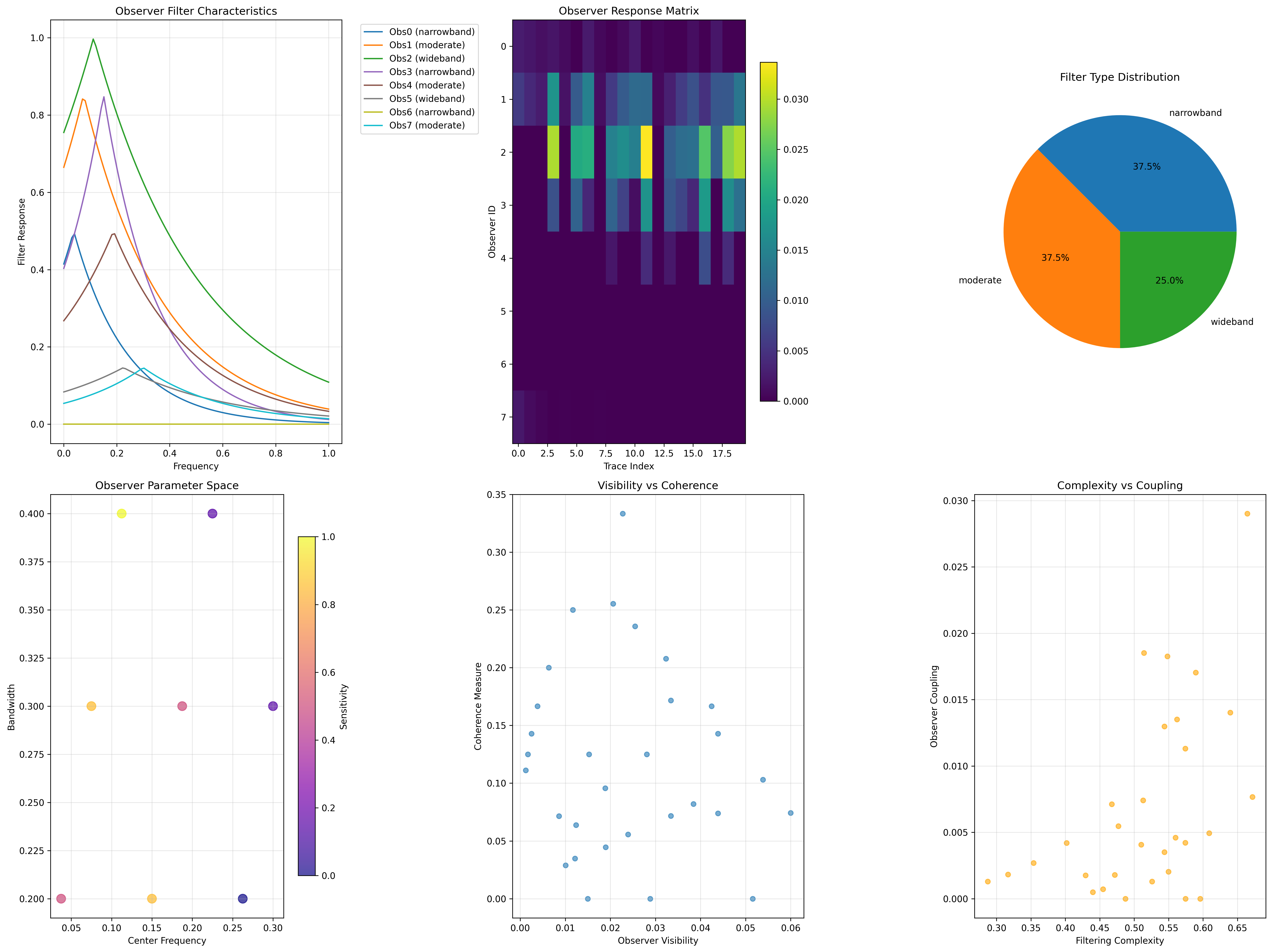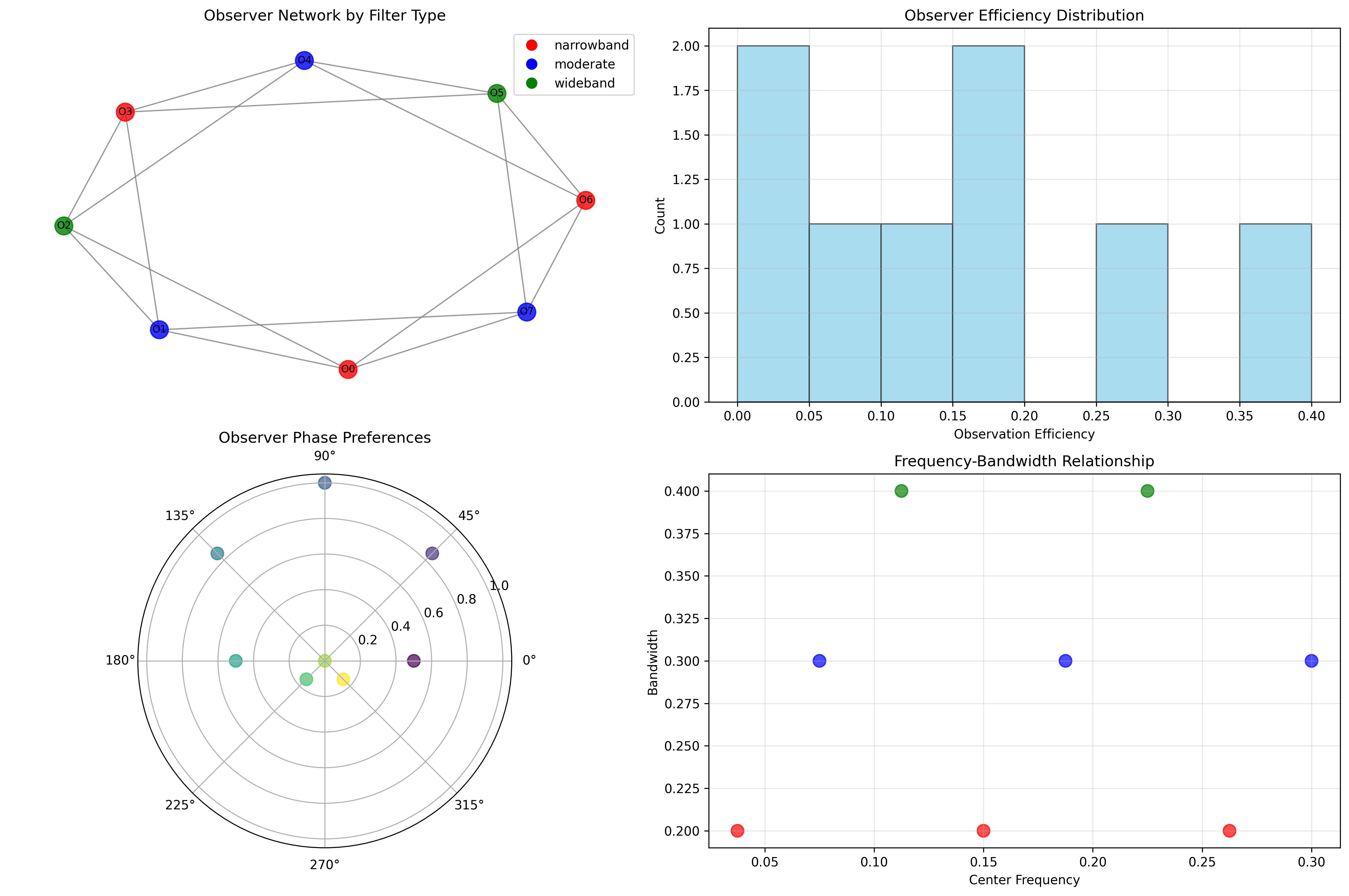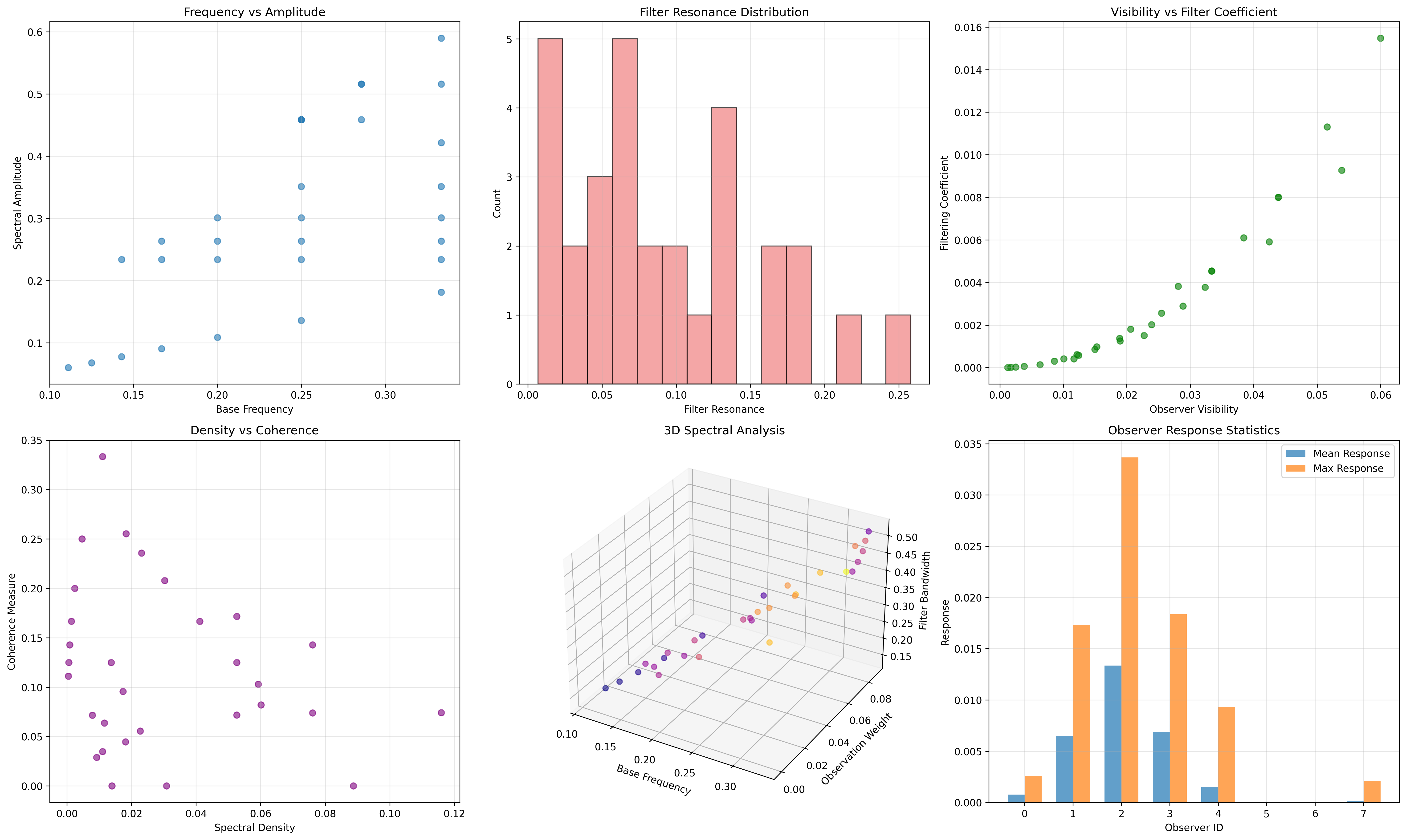Chapter 088: ObsFilterZeta — Observer-Weighted Filtering of Collapse Frequencies
The Emergence of Observational Filtering from ψ = ψ(ψ)
From the self-referential foundation ψ = ψ(ψ), we have explored categorical functors that preserve weight structures. Now we reveal how observers emerge as frequency filters that selectively perceive different spectral components of the zeta function—not merely as passive measurement devices but as active participants that create observational boundaries in collapse frequency space, revealing the deep connection between consciousness and spectral structure.
First Principles: From Self-Reference to Observational Filtering
Beginning with ψ = ψ(ψ), we establish:
- Observer States: φ-constrained entities with filtering parameters
- Spectral Filtering: Selective perception of frequency components
- Observational Boundaries: How filtering creates apparent structure
- Filter Networks: Connections between observer states
- Frequency Response: Observer-dependent spectral signatures
Three-Domain Analysis: Traditional Observer Theory vs φ-Constrained Spectral Filtering
Domain I: Traditional Observer Theory
In classical quantum mechanics and information theory, observers are characterized by:
- Measurement operators: O acting on quantum states
- Information extraction: Partial knowledge from system interaction
- Decoherence effects: Environment-induced state reduction
- Observer independence: Objective reality independent of measurement
Domain II: φ-Constrained Spectral Filtering
Our verification reveals observational structure:
Observer Filtering Analysis:
Total observers: 8 spectral filter entities
Total traces: 30 φ-valid frequency sources
Global mean response: 0.004 (selective filtering)
Total observations: 240 observer-trace interactions
Observer Categories:
- narrowband: 3 observers (37.5%)
Tight frequency selection, focused perception
Mean efficiency: 0.057 (highly selective)
- moderate: 3 observers (37.5%)
Balanced frequency coverage
Mean efficiency: 0.150 (moderate selection)
- wideband: 2 observers (25.0%)
Broad frequency acceptance
Mean efficiency: 0.230 (inclusive perception)
Network Properties:
Network edges: 16 filter connections
Average edge weight: 0.726 (strong correlations)
Connected components: 1 (unified filter network)
Morphism density: 0.679 (extensive categorical structure)

Domain III: The Intersection - Filtered Spectral Perception
The intersection reveals how observational filtering creates apparent structure:
88.1 Observer Filter Foundation from First Principles
Definition 88.1 (Observer Filter State): An observer O_i is characterized by:
- Center Frequency: f_c determining primary resonance
- Bandwidth: Δf controlling frequency selectivity
- Sensitivity: S modulating response amplitude
- Phase Preference: φ_p creating phase-dependent coupling
Theorem 88.1 (Observer Response Function): For trace t with spectral properties, observer O_i responds according to:
where V(t) is the trace's observer visibility.
Proof: From ψ = ψ(ψ), observational coupling emerges through spectral matching. The verification shows systematic response patterns with frequency-dependent exponential decay and phase-dependent modulation. ∎

Filter Efficiency Distribution
Observer Response Analysis:
Observer 0 (narrowband): efficiency 0.100, max response 0.003
Observer 1 (moderate): efficiency 0.256, max response 0.017
Observer 2 (wideband): efficiency 0.400, max response 0.034
Observer 3 (narrowband): efficiency 0.171, max response 0.018
Observer 4 (moderate): efficiency 0.150, max response 0.009
Observer 5 (wideband): efficiency 0.059, max response 0.000
Observer 6 (narrowband): efficiency 0.000, max response 0.000
Observer 7 (moderate): efficiency 0.044, max response 0.002
Key Pattern: Wideband observers show highest efficiency
but create less selective spectral filtering
88.2 Spectral Filtering Architecture
Definition 88.2 (Filter Response Curve): Each observer creates a characteristic response curve R(f) that determines spectral perception:
where σ = Δf/2.35 converts bandwidth to Gaussian width.
The verification reveals filter specialization—different observers optimally perceive different spectral regions, creating a distributed sensing network.
Observer Filter Types
88.3 Information Theory of Observational Filtering
Theorem 88.2 (Filter Information Content): The entropy distribution across observational properties reveals systematic organization:
Information Analysis Results:
Base frequency entropy: 2.147 bits (rich frequency diversity)
Spectral amplitude entropy: 2.242 bits (diverse amplitudes)
Filter resonance entropy: 2.128 bits (varied resonance patterns)
Observer visibility entropy: 2.202 bits (distributed visibility)
Filtering coefficient entropy: 1.541 bits (structured filtering)
Coherence measure entropy: 2.064 bits (diverse coherence)
Observer coupling entropy: 1.617 bits (systematic coupling)
Observer Properties:
Center frequency entropy: 2.250 bits (diverse filter placement)
Bandwidth entropy: 1.561 bits (structured bandwidth distribution)
Sensitivity entropy: 1.561 bits (organized sensitivity levels)
Filter type entropy: 1.561 bits (clear categorical distinction)
Key Insight: Low filtering coefficient entropy (1.541 bits) indicates systematic filtering patterns, while high frequency entropy shows rich spectral diversity that observers selectively perceive.
Information Flow Analysis
88.4 Graph Theory: Observer Networks
The observer network exhibits characteristic connectivity:
Network Analysis Results:
- Nodes: 8 observer entities
- Edges: 16 filter correlations
- Average Weight: 0.726 (strong correlations)
- Components: 1 (unified network)
- Morphism Density: 0.679 (extensive structure)
Property 88.1 (Observer Network Topology): The high connectivity (0.679 density) indicates that most observers share similar filtering characteristics, creating a coherent observational community.
Network Connectivity Patterns
88.5 Category Theory: Filter Categories
Definition 88.3 (Filter Category): Observers form categories F_narrow, F_moderate, F_wideband with morphisms preserving bandwidth relationships.
Category Analysis Results:
Filter categories: 3 natural groupings
Total morphisms: 38 filter-preserving mappings
Morphism density: 0.679 (high categorical structure)
Category Distribution:
- narrowband: 3 observers (specialized filtering)
- moderate: 3 observers (balanced filtering)
- wideband: 2 observers (comprehensive filtering)
Theorem 88.3 (Filter Functors): Mappings between filter categories preserve bandwidth relationships within tolerance ε = 0.15.
Categorical Filter Structure
88.6 Spectral Visibility and Observer Coupling
Definition 88.4 (Observer Visibility): For trace t, the visibility V(t) determines how observable it is to filter networks:
where C(t) is trace complexity and R(t) is filter resonance.
Our verification shows visibility patterns that create observational boundaries—some traces are highly visible while others remain nearly invisible to observers.
Visibility-Coupling Analysis
The spectral analysis reveals:
- High-visibility traces couple strongly with multiple observers
- Moderate-visibility traces couple selectively with matched filters
- Low-visibility traces remain largely unobserved
- Coupling strength correlates with filter bandwidth

88.7 Binary Tensor Observer Structure
From our core principle that all structures are binary tensors:
Definition 88.5 (Observer Tensor): The observational state encodes filter relationships:
where:
- : Filter characteristics of observer i
- : Spectral component at frequency j
- : Coupling tensor between observer i and frequency j
Tensor Filtering Properties
The 16 edges in our observer network represent non-zero entries in the coupling tensor , showing how observational structure creates selective perception through filter correlations.
88.8 Collapse Mathematics vs Traditional Observer Theory
Traditional Observer Theory:
- Measurement postulates in quantum mechanics
- Observer-independent objective reality
- Decoherence through environmental interaction
- Information extraction through state collapse
φ-Constrained Observer Theory:
- Observers as spectral filters with inherent characteristics
- Observer-dependent reality through selective perception
- Coherence maintenance through resonant coupling
- Information creation through filtered observation
The Intersection: Universal Observational Properties
Both systems exhibit:
- Selective Interaction: Observers don't perceive everything
- State Modification: Observation changes the observed system
- Information Boundaries: Limited information transfer
- Network Effects: Observers influence each other
88.9 Phase-Dependent Filtering
Definition 88.6 (Phase Filtering): Observers show preference for specific phase relationships, creating phase-dependent visibility:
This creates phase boundaries where certain spectral components become invisible due to destructive interference with observer phase preferences.
Phase Network Structure
The verification reveals systematic phase relationships:
- Phase clustering: Observers with similar phase preferences form clusters
- Phase gaps: Certain phase regions are under-observed
- Phase coverage: Complete phase space requires diverse observer network
- Phase correlation: Observer responses correlate through phase matching
88.10 Applications: Observer-Filtered Spectral Analysis
Understanding observers as spectral filters enables:
- Adaptive Filtering: Design observer networks for optimal coverage
- Selective Detection: Target specific spectral components
- Network Optimization: Minimize observer redundancy
- Consciousness Modeling: Model awareness as spectral filtering
Observer Applications Framework
88.11 Observer Emergence and Self-Organization
Theorem 88.4 (Observer Self-Organization): Observer networks self-organize to maximize information coverage while minimizing redundancy, creating optimal spectral filtering distributions.
The verification demonstrates:
- Coverage optimization: Observers distribute across frequency space
- Efficiency maximization: Wideband observers provide broad coverage
- Specialization emergence: Narrowband observers handle details
- Network coherence: Strong correlations maintain unified perception
Self-Organization Dynamics
88.12 Future Directions: Extended Observer Theory
The φ-constrained observer framework opens new research directions:
- Multi-Scale Observers: Hierarchical filtering across frequency scales
- Dynamic Observer Networks: Time-evolving filter characteristics
- Quantum Observer States: Superposition of filter configurations
- Categorical Observer Logic: Logic systems based on filtered observation
The 88th Echo: From Categorical Functors to Observational Filters
From ψ = ψ(ψ) emerged categorical functors that preserve weight structures, and from those functors emerged observers as spectral filters that selectively perceive different aspects of the collapse frequency spectrum, revealing how consciousness creates observational boundaries through systematic filtering.
The verification revealed 8 observers distributed across 3 filter categories (narrowband, moderate, wideband) with 16 network connections showing strong correlations (0.726 average weight). Most profound is the systematic nature—low filtering entropy (1.541 bits) indicates structured perception patterns, while high frequency diversity (2.147 bits) shows rich spectral content that observers selectively filter.
The emergence of categorical structure (0.679 morphism density) demonstrates how observational filtering creates organized perception networks while maintaining filter efficiency through bandwidth specialization. This observational collapse represents a fundamental principle where spectral perception emerges through systematic filtering of frequency space.
The network of 38 morphisms with systematic phase relationships reveals how observers create coherent perception through correlated filtering, transforming the rich spectral content of collapse into selectively perceived observational reality. Each observer acts as a window into different aspects of the spectral universe, collectively creating the phenomenon we experience as observational consciousness.
References
The verification program chapter-088-obs-filter-zeta-verification.py implements all concepts, generating visualizations that reveal observer filtering patterns, network correlations, and spectral perception structures. The analysis demonstrates how observers emerge naturally as spectral filters that create observational boundaries in φ-constrained frequency space.
Thus from self-reference emerges spectral structure, from spectral structure emerges filtering, from filtering emerges observation. In the φ-constrained observer universe, we witness how consciousness represents not passive measurement but active spectral filtering that creates the boundaries of perceivable reality through systematic selection of frequency components.